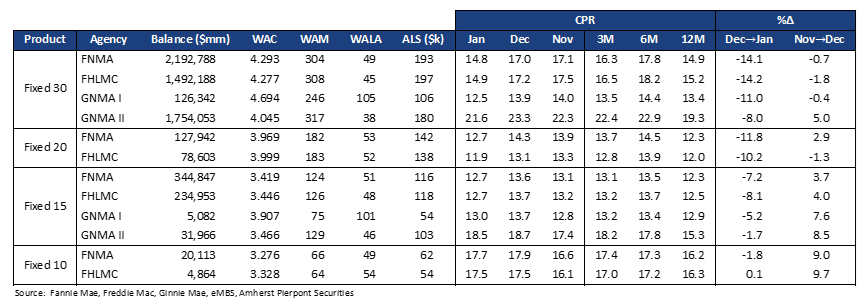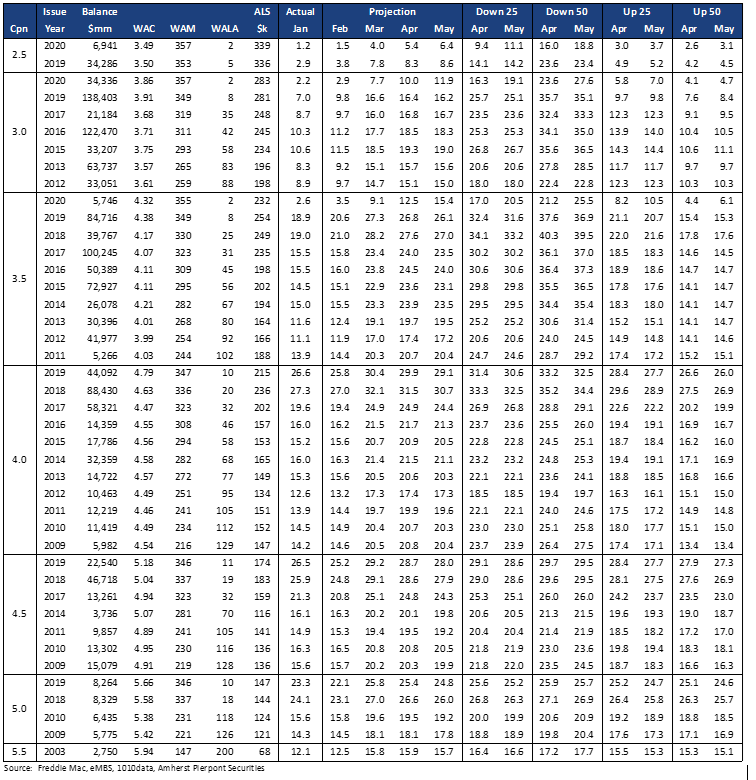Uncategorized
The January lull in prepayment speeds won’t last
admin | February 7, 2020
This document is intended for institutional investors and is not subject to all of the independence and disclosure standards applicable to debt research reports prepared for retail investors. This material does not constitute research.
January speeds often surprise to the slow side, and the start to 2020 to was no exception. Ginnie Mae speeds slowed less than those of conventional 30-years, slightly widening the prepayment gap which has opened over the past few months. However, interest rates have fallen once again, and low WALA Ginnie Mae pools may offer the best protection from the faster prepayment speeds coming in February and March.
Fannie Mae and Freddie Mac 30-year prepayment speeds dropped 14% in January, a little more than expected. Lagged mortgage rates were roughly unchanged and there were an additional 1.5 business days, which should have prevented speeds from falling as much as they did.
Ginnie Mae speeds also slowed, but not by as much as conventionals. For the last few months Ginnie Mae MBS have widened their prepayment gap with conventionals. Many FHA and VA borrowers are finally becoming eligible for government refinance programs, pushing speeds faster. But Ginnie Mae MBS have strong prepayment protection at low WALAs, even better than low WALA conventional MBS. Therefore low WALA Ginnie Mae pools may be a good way to find shelter from the faster prepayment speeds expected in February and March.
Exhibit 1: Speeds slow in January, especially conventionals

Source: Fannie Mae, Freddie Mac, Ginnie Mae, eMBS, Amherst Pierpont Securities
Looking ahead
Interest rates have fallen again and mortgage rates are lower than at any point during 2019. Therefore prepayment speeds are set to accelerate. Lagged mortgage rates are about 12 basis points lower in February than January, which should push prepayment speeds 5 to 10% faster despite fewer business days. And if interest rates remain near current levels prepayment speeds should explode in March. A longer month, faster housing turnover, and most importantly an additional 15 basis point drop in lagged mortgage rates could push prepayment speeds 40 to 45% faster. This would be similar to October 2019, the fastest month last year.
The MBA refinance index confirms faster speeds are pending
The forecast for faster speeds is evident in the MBA refinance index (Exhibit 2). The index is almost 50% higher than levels from early December and has surpassed the peak level of 2019. Interestingly, most of the gain came from the conventional index, substantially narrowing the gap to the government index.
Exhibit 2: MBA Refinance Index

Source: Bloomberg, Amherst Pierpont Securities
Faster conventional prepayment speeds could cause the Ginnie Mae TBA to strengthen relative to conventionals. Fear of faster government prepayments has caused Ginnie Mae TBA to significantly underperform conventional TBA over the past few weeks. But the MBA refinance index suggests that conventional speeds could increase more than Ginnie Mae speeds.
Ginnie Mae pools also offer better low WALA prepayment protection than conventional pools, since the FHA and VA are in a stronger position to prohibit low WALA refinancing than conventional lenders and the GSEs. Low WALA Ginnie Mae pools may be an inexpensive source of near-term prepayment protection, and if interest rates increase before the borrowers become refinanceable then fast speeds may never materialize. This topic is discussed in detail here.
The Fannie Mae and Freddie Mac numbers
Fannie Mae and Freddie Mac prepayment speeds both slowed 14% in January. Speeds slowed pretty consistently across the stack, but most of the decline came in moderately seasoned and seasoned vintages. 2018 and 2019 production either didn’t slow nearly as much as older vintages. One cohort—Fannie Mae 3.0%s 2019—actually increased 6.5% to 6.5 CPR from 6.1 CPR.
Strong prints in 2019 Ginnie Mae MBS
Overall Ginnie Mae prepayment speeds did not slow as much as conventionals. For example, Ginnie Mae II prepayment speeds slowed only 8%. But most cohorts slowed roughly 10 to 15%, in-line with conventionals. The 2019 vintage was the exception—as borrowers become eligible for refinancing these speeds increase dramatically. For example, the 3.0%s 2019 increased 75.9% to 4.0 CPR from 2.3 CPR—a massive increase compared to the gain on the same Fannie Mae cohort, although absolute speeds have not yet caught up to Fannie.
A second example are Ginnie Mae II 3.5%s, which increased 56.7% to 23.8 CPR from 15.9 CPR. This cohort prepaid 1.8 CPR slower than the same conventional cohort in December but prepaid 6.7 CPR faster in January.
Data Tables
Exhibit 3: Prepayment Summary

Our short term forecast is shown in Exhibit 6 (Fannie Mae) and Exhibit 7 (Freddie Mac). Exhibit 5 shows the static rates used in the prepayment forecast.
Exhibit 4: Agency Speeds, Largest Cohorts

Exhibit 5: Mortgage Rate Forecast

Exhibit 6: Fannie Mae Short Term Forecast

Exhibit 7: Freddie Mac Short Term Forecast



